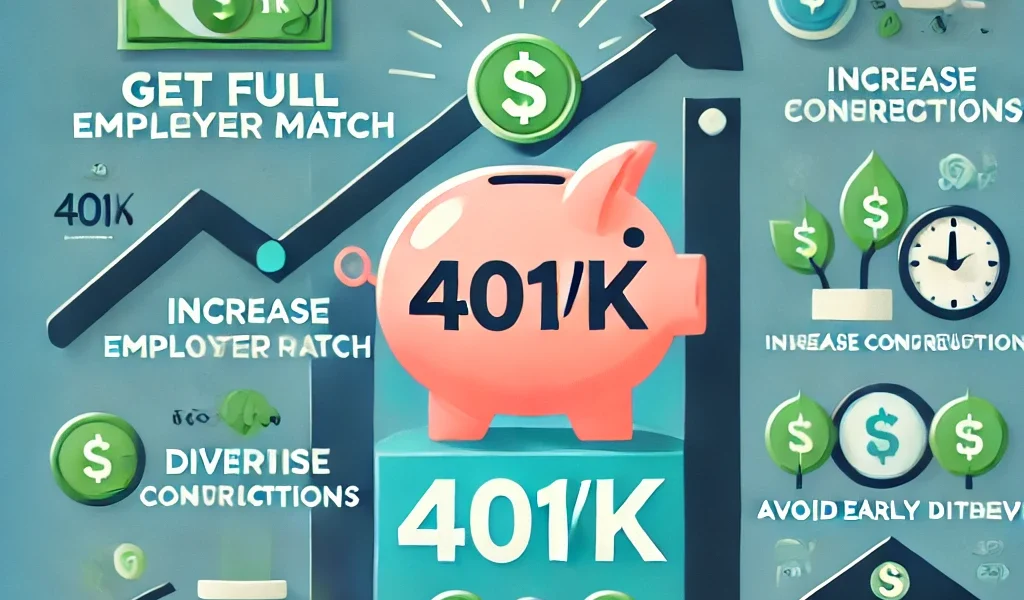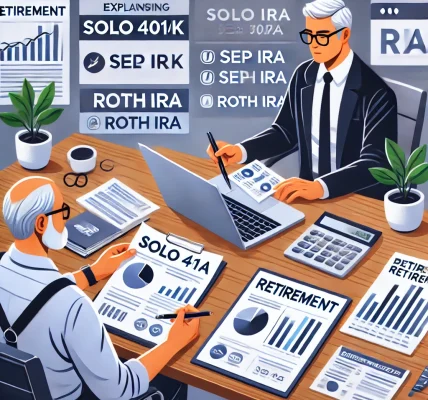Maximizing Your 401(k): Tips for Boosting Your Retirement Savings – Which One Offers the Best Returns?
A 401(k) retirement plan is one of the most powerful tools available to help you build wealth for the future. However, simply contributing to a 401(k) is not enough—you need a strategy to maximize your returns and ensure you have enough savings for a comfortable retirement.
In this guide, we’ll explore proven tips to maximize your 401(k), key investment strategies, and ways to optimize your contributions for the best returns. Whether you’re just starting your career or nearing retirement, these insights will help you make the most of your retirement savings.
Understanding the Basics of a 401(k) Plan
A 401(k) is an employer-sponsored retirement savings plan that allows employees to contribute a portion of their salary into a tax-advantaged investment account. Employers may also offer a matching contribution, which is essentially free money that can boost your savings.
There are two main types of 401(k) plans:
- Traditional 401(k): Contributions are made pre-tax, reducing your taxable income. Withdrawals during retirement are taxed as ordinary income.
- Roth 401(k): Contributions are made after-tax, meaning withdrawals in retirement are tax-free if certain conditions are met.
Both options provide long-term investment growth, but the right choice depends on your current and future tax situation.
How to Maximize Your 401(k) Contributions
1. Contribute Enough to Get the Full Employer Match
Many employers offer a 401(k) match, where they contribute a percentage of your salary to your retirement account based on your own contributions.
For example, if your employer offers a 100% match up to 5% of your salary, and you earn $60,000 per year, then contributing at least 5% ($3,000) ensures you receive an additional $3,000 from your employer.
Why It Matters:
✔ Free money that boosts your savings
✔ Increases compound growth over time
✔ Helps you reach retirement goals faster
💡 Tip: Always contribute enough to get the full match—it’s essentially a 100% return on your investment!
2. Increase Your Contributions Over Time
If you’re not yet contributing the maximum amount to your 401(k), consider increasing your contributions gradually.
- IRS Contribution Limit for 2024: $23,000 (or $30,500 if age 50+)
- Employer Match Limit: Employers can contribute up to a combined total of $69,000
Why It Matters:
✔ Maximizes tax-deferred or tax-free growth
✔ Helps you build a larger retirement fund
✔ Reduces taxable income (for Traditional 401(k) holders)
💡 Tip: Set an automatic annual increase of 1-2% until you reach the maximum contribution limit.
3. Diversify Your Investment Portfolio
A 401(k) offers various investment options, including stocks, bonds, mutual funds, and target-date funds. The key to maximizing returns is proper diversification.
Best Investment Strategy for a 401(k):
✅ Stocks for Growth – Invest in stock index funds or growth funds for higher long-term returns.
✅ Bonds for Stability – Allocate a portion to bonds to balance risk, especially as you near retirement.
✅ Target-Date Funds – These automatically adjust asset allocation based on your expected retirement date.
Why It Matters:
✔ Reduces overall risk
✔ Optimizes growth based on your retirement timeline
✔ Balances returns and security
💡 Tip: Rebalance your portfolio annually to maintain the right mix of investments.
4. Take Advantage of Roth 401(k) Benefits
If your employer offers a Roth 401(k) option, consider contributing to it—especially if you expect to be in a higher tax bracket in retirement.
Why Roth 401(k) Can Be a Smart Choice:
✔ Tax-free withdrawals in retirement
✔ No required minimum distributions (RMDs) at age 73 (if rolled into a Roth IRA)
✔ Ideal for young investors with decades of growth potential
💡 Tip: If unsure, split your contributions between Traditional 401(k) and Roth 401(k) for tax flexibility.
5. Avoid Early Withdrawals & Loans
Withdrawing funds from your 401(k) before age 59½ can result in:
🚨 A 10% early withdrawal penalty
🚨 Income tax on withdrawn funds
🚨 A significant loss of long-term growth
Similarly, taking a 401(k) loan can reduce your investment returns and may require immediate repayment if you leave your job.
💡 Tip: Only consider a 401(k) loan as a last resort—use emergency savings first.
6. Take Advantage of Catch-Up Contributions (If 50 or Older)
Once you turn 50, you can contribute an extra $7,500 per year beyond the normal IRS limit.
Why It Matters:
✔ Helps late savers boost their retirement funds
✔ Provides additional tax savings
💡 Tip: If you’re behind on retirement savings, maximize catch-up contributions to secure your financial future.
Which 401(k) Investment Strategy Offers the Best Returns?
1. Aggressive Growth Strategy (For Young Investors)
- Stock-heavy allocation (80%-90%)
- Index funds or ETFs with low fees
- Maximize Roth 401(k) for tax-free growth
🔹 Best for: Individuals in their 20s-40s looking for high long-term returns.
2. Balanced Strategy (For Mid-Career Investors)
- 60%-70% in stocks, 30%-40% in bonds
- Mix of growth & dividend-paying funds
- Rebalance annually to maintain risk tolerance
🔹 Best for: Individuals in their 40s-50s who want steady growth with lower risk.
3. Conservative Strategy (For Pre-Retirees & Retirees)
- 50% or more in bonds/cash equivalents
- Focus on dividend stocks & conservative funds
- Ensure enough liquidity for withdrawals
🔹 Best for: Individuals close to retirement looking for security over high growth.
Final Thoughts: How to Get the Most Out of Your 401(k)
✅ Contribute enough to get the full employer match – It’s free money!
✅ Increase your contributions over time – Even 1-2% annually makes a huge difference.
✅ Diversify your investments – A well-balanced portfolio boosts returns.
✅ Consider Roth 401(k) for tax-free withdrawals – Especially if you expect higher taxes later.
✅ Avoid early withdrawals & loans – Protect your long-term savings.
✅ Use catch-up contributions if 50+ – Boost your retirement security.
By following these strategies, you’ll maximize your 401(k) savings, optimize your investment returns, and secure a comfortable retirement.
Disclaimer:
This article is for informational purposes only and does not constitute financial or legal advice. Please consult with a financial advisor before making investment decisions.




